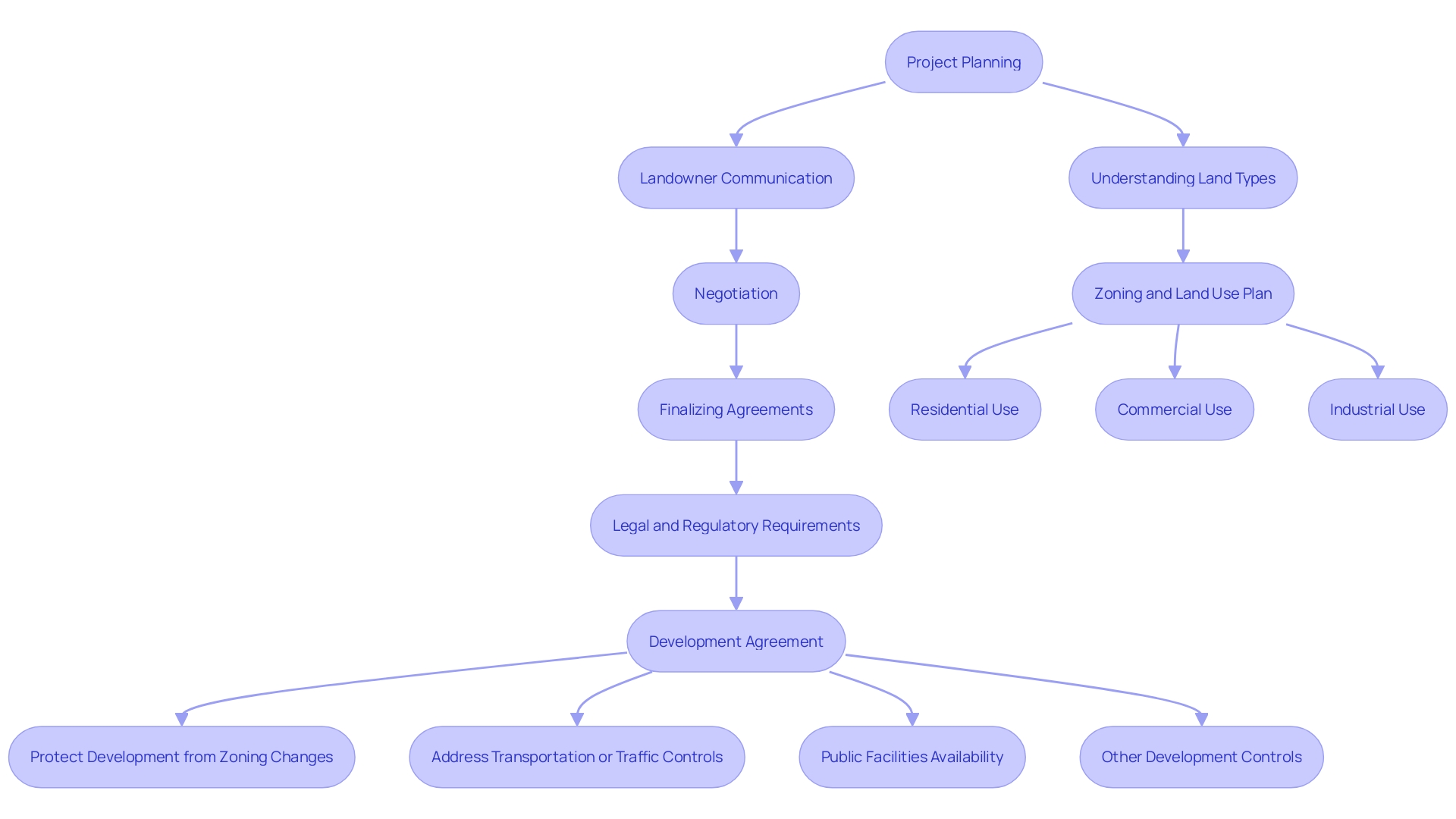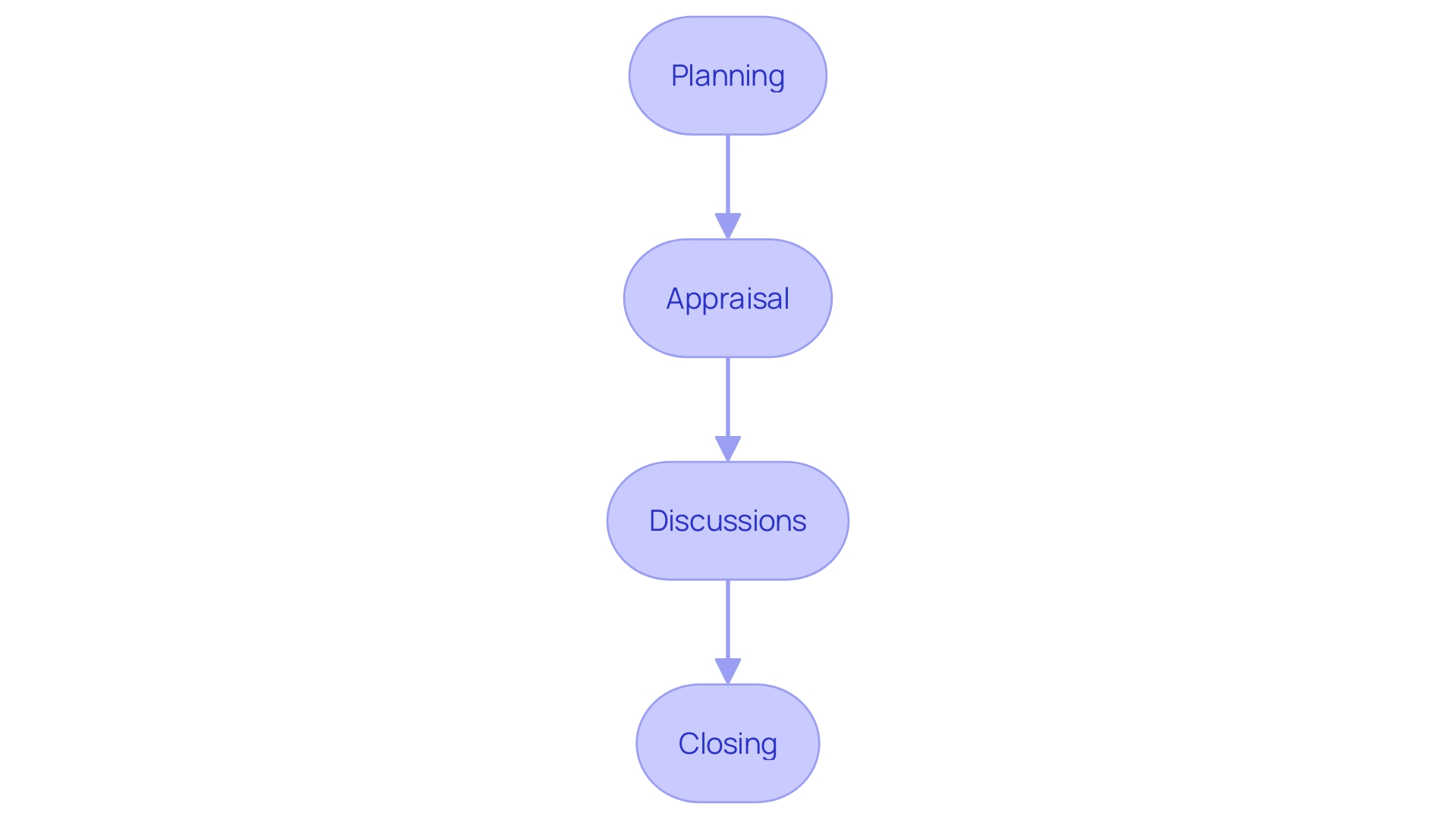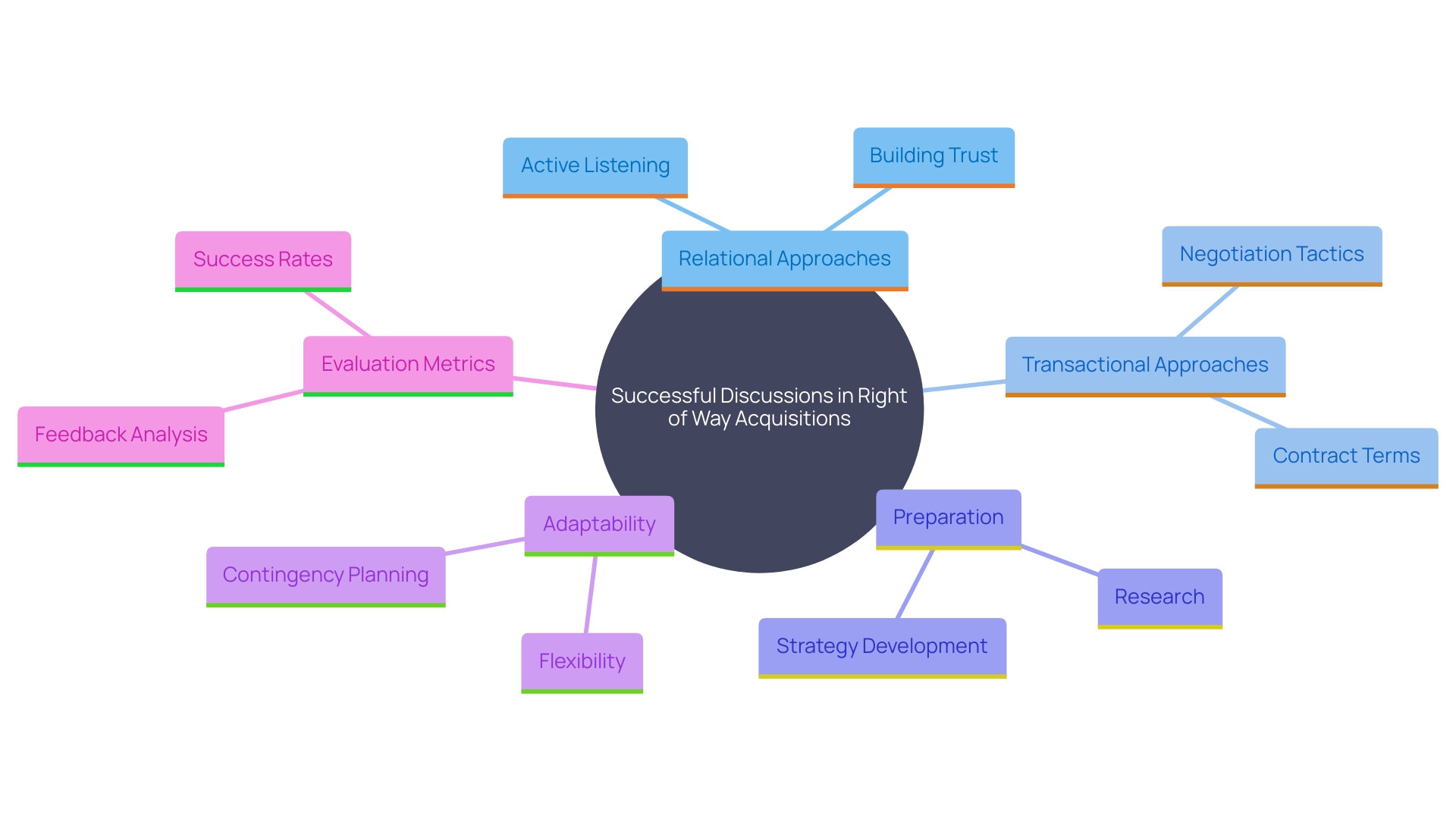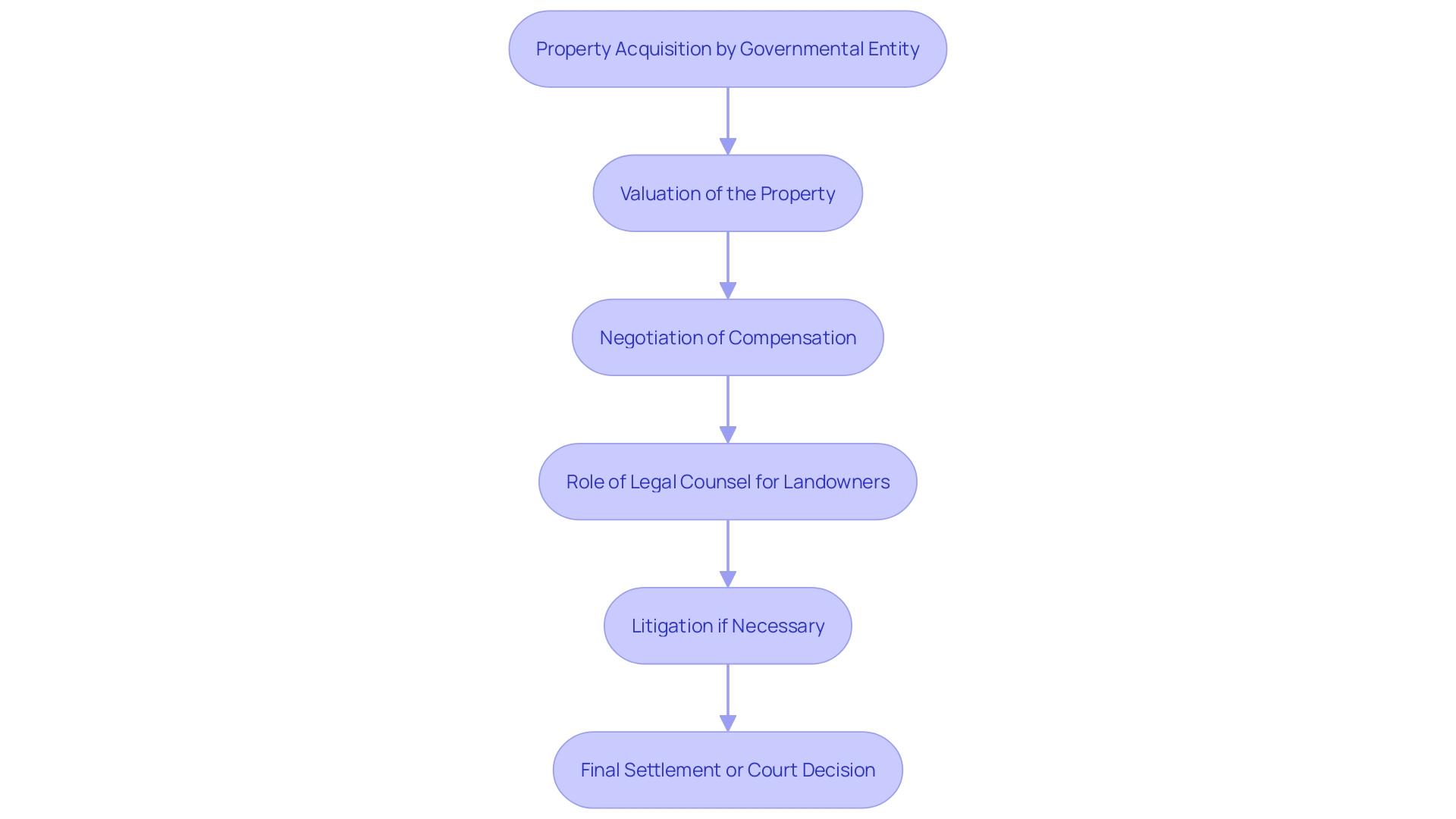Introduction
Navigating the complexities of right of way acquisition is essential for the successful completion of infrastructure projects. This article delves into the critical stages of the acquisition process, from project planning and landowner outreach to negotiation and agreement finalization. Key insights into the legal frameworks, negotiation techniques, and best practices are provided to ensure transparency and fairness.
With the Infrastructure Investment and Jobs Act fueling numerous projects, understanding these processes becomes even more pertinent. Case studies highlight practical applications and lessons learned, offering valuable perspectives for both landowners and acquiring entities.
Understanding the Right of Way Acquisition Process
The process of obtaining access includes several essential phases: project planning, landowner communication, negotiation, and finalizing agreements. Understanding these stages is crucial for both landowners and acquiring entities to ensure a seamless transaction. The initial phase typically involves identifying the necessity for acquisition, followed by a comprehensive assessment of the required land. For instance, a detailed environmental due diligence process, including Phase I and Phase II environmental site assessments, can help identify, quantify, and assess risks and liabilities.
Involving legal counsel and experienced negotiators early in the process can significantly enhance outcomes. Jennifer Flickinger, a government contracts group partner at HKA Global, emphasizes that "there are so many ways you can find yourself up against a wall at this moment if you are taking federal funds." This highlights the importance of navigating complex legal and regulatory requirements effectively.
Furthermore, the Infrastructure Investment and Jobs Act has introduced a wave of IIJA-funded initiatives, particularly in the roads and bridges sector, scheduled to conclude in 2024. Maria Lehman, vice chair of the President's National Infrastructure Advisory Council, observes a transition towards a more comprehensive, innovative, and cooperative method in the industry, which is essential for managing the changing environment of property procurements.
Case studies, such as a developer's endeavor at the intersection of Golf Road and Golf Court, illustrate the practical application of these principles. The endeavor entailed obtaining suitable entry permissions on both public and private lands, showcasing the significance of careful planning and stakeholder involvement in the procurement process.

Key Phases of Right of Way Acquisition
'Right of way acquisition includes several crucial stages: planning, appraisal, discussions, and closing.'. In the planning phase, stakeholders define objectives and pinpoint necessary land parcels. During appraisal, the fair market value of the property is assessed to ensure equitable compensation. The discussion phase is crucial for reaching mutually beneficial agreements with landowners. Finally, the closing phase ensures that all legal documentation is properly executed, and any required compensation is distributed. This organized method guarantees clarity and equity, essential for the successful conclusion of infrastructure endeavors, particularly considering new federal regulations and funding opportunities.

Negotiation Techniques for Successful Acquisition
Successful discussion is crucial in right of way acquisitions, requiring a blend of relational and transactional approaches. Establishing clear communication and understanding the landowner's perspective is fundamental. This can be accomplished through active listening and offering clear information about the benefits, thereby fostering trust and rapport. As Shauna Gamble illustrates, negotiating should not be adversarial but rather a collaborative effort to understand and align interests, leading to mutually beneficial outcomes.
Preparation plays a critical role in successful discussions. It involves thorough research and understanding of the landowners' needs, market conditions, and project details. Such preparedness allows negotiators to address concerns effectively and steer conversations towards favorable conclusions. Adaptability is equally important, as discussions often present unforeseen challenges requiring swift, strategic pivots.
High-stakes discussions benefit from continuous, realistic training that goes beyond techniques to include effective communication and collaboration. As discussions are not a one-time process but rather dynamic and ongoing, maintaining flexibility is crucial. This approach has proven successful in various scenarios, from securing higher salaries to managing complex land acquisition deals.
Consistent evaluations and client satisfaction questionnaires can assess the success of discussions. Successful discussions often lead to shorter sales cycles, higher customer satisfaction, repeat business, and improved profit margins. These metrics highlight the significance of negotiation abilities in attaining favorable, lasting results in land purchases.

Legal Aspects and Eminent Domain Considerations
Comprehending the legal structure regarding easement procurement is essential for both sides involved. Eminent domain laws grant governmental entities the authority to acquire private property for public use, but they must adhere to specific procedures and provide just compensation. For instance, in a recent case involving the Texas Parks and Wildlife Department, a panel valued the seized property at $418.3 million, ensuring the landowner received a fair market value. Likewise, the city of Fort Worth has employed eminent domain six times since 2020 for infrastructure developments, highlighting the significance of fairly compensating property owners.
It is essential for landowners to understand their rights and the legal consequences of the purchasing process. Consulting with legal experts can help navigate complexities and ensure compliance with relevant laws. For example, in cases where the government modifies access points during road widening or bridge repair projects, property owners may face significant changes that could impact their property's value. Legal counsel can provide guidance on seeking compensation for such adjustments.
In high-profile acquisitions, as seen in Fort Worth's $850 million allocation for infrastructure improvements, the necessity for legal expertise becomes evident. Landowners need to understand that while governmental entities possess the authority to seize land for public use, they are also obligated to negotiate and provide fair compensation. Collaborating with legal experts guarantees that landowners' entitlements are safeguarded during the process, making the complex realm of way laws more manageable and fair.

Case Studies and Lessons Learned
'Examining case studies of previous right of way purchases offers critical insights into best practices and common challenges.'. For instance, Jacobs has been instrumental in developing and executing strategies related to the Lead and Copper Rule for over 30 years, safeguarding millions across the U.S. and Canada. Their comprehensive approach, which includes enhanced water quality monitoring and corrosion control studies, underscores the importance of early stakeholder engagement and thorough communication strategies.
In a similar vein, the stakeholder teams on Craig Street engaged with various community members such as pedestrians, cyclists, and business owners to understand their needs and interests, demonstrating the effectiveness of proactive problem-solving approaches. This initiative highlights how successful projects often rely on detailed planning and collaboration from the outset.
Furthermore, Jacobs' commitment to addressing climate emergencies and integrating equity and environmental justice into compliance programs exemplifies how previous experiences can guide future acquisitions. By learning from these real-world examples, acquiring entities can refine their strategies, ensuring more effective outcomes for both landowners and developers.
Conclusion
The right of way acquisition process involves critical stages, including project planning, landowner outreach, negotiation, and agreement finalization. A thorough understanding of these stages is essential for both landowners and acquiring entities to ensure effective transactions. Key assessments and legal counsel play a vital role in navigating the complexities of federal regulations, especially with the new projects under the Infrastructure Investment and Jobs Act.
Each phase—planning, appraisal, negotiation, and closing—promotes transparency and fairness, ensuring equitable compensation and successful project execution. Effective negotiation techniques, such as clear communication and understanding landowners' perspectives, are crucial for fostering collaboration and trust. Preparation and adaptability are necessary for overcoming challenges during negotiations.
Legal considerations, particularly concerning eminent domain, are significant in the acquisition process. Landowners must be aware of their rights and legal implications, while consulting legal experts helps ensure compliance and protection of interests.
Case studies offer essential insights into best practices and common challenges in right of way acquisitions. Proactive stakeholder engagement and a focus on environmental and equity considerations can lead to improved outcomes. By learning from past experiences, acquiring entities can enhance their strategies, ultimately benefiting both landowners and the communities involved in infrastructure development.




